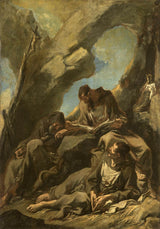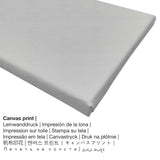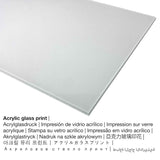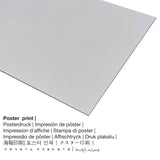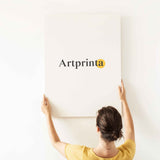Alessandro Magnasco, 1710 - Ndị mọnk Camaldolese atọ n'ekpere ntụgharị uche - mbipụta nka mara mma.
Ụtụ gụnyere. Mbupu gbakọrọ na ndenye ọpụpụ.
Ngwa ngwaahịa dị
Maka mbipụta nka ọ bụla, anyị na-enye nha & ihe dị iche iche. Ị nwere ike ịhọrọ nha na ihe kachasị amasị gị n'ime nhọrọ ndị a:
- Mbipụta kanvas: A UV printed canvas stretched on a wood stretcher frame. The advantage of canvas prints is that they are relatively low in weight, which implies that it is easy to hang your Canvas print without the help of any wall-mounts. Hence, canvas prints are suitable for all types of walls.
- Aluminom ihe eji eme ihe: Aluminium Dibond prints are prints on metal with a true depth effect. For our Aluminium Dibond print, we print the favorite work of art right on the surface of the white-primed aluminum material.
- Akwụkwọ mmado ebipụtara (ihe kwaaji): Our poster is a UV printed flat cotton canvas paper with a slightly rough structure on the surface. It is perfectly qualified for putting the fine art print in a custom-made frame. Please note, that depending on the size of the canvas poster print we add a white margin of approximately 2-6cm round about the print, which facilitates the framing.
- Glass acrylic e biri ebi (nwere ezigbo mkpuchi iko): An print on acrylic glass, often referred to as a an art print on plexiglass, will change the original into beautiful décor. The great advantage of an acrylic glass art print is that contrasts and artwork details will be exposed thanks to the very fine gradation of the picture.
Ihe dị mkpa: We try the best we can in order to describe the products in as much detail as we can and to display them visually in our shop. Still, the pigments of the printing material and the printing can vary marginally from the image on your device's monitor. Depending on your settings of your screen and the quality of the surface, color pigments can unfortunately not be printed as exactly as the digital version depicted here. Considering that all our fine art prints are processed and printed manually, there may also be minor deviations in the motif's exact position and the size.
Nkọwa zuru oke sitere na Rijksmuseum (© - site na Rijksmuseum - Rijksmuseum)
Three Capuchin monks meditating in prayer before a crucifix in a cave. Two monks are beaten open books for himself, the third hugging a crucifix. Pendant of SK-C-1358.
Three Camaldolese Monks in Meditative Prayer was created by Alessandro Magnasco. This artwork is in the the digital collection of Rijksmuseum, nke dị na Amsterdam, Netherlands. Anyị nwere obi ụtọ ikwu na ọrụ nka, nke bụ nke ngalaba ọha a na-enye ya site n'ikike nke Rijksmuseum.: . Na mgbakwunye na nke ahụ, nhazi ahụ dị na Eserese format ya na oke nke 1: 1.4, which means that the length is 29% shorter than the width. The painter Alessandro Magnasco was a European artist, whose art style can primarily be classified as Baroque. The European painter was born in the year 1667 in Genoa, Genova province, Liguria, Italy and died at the age of 82 in 1749 in Genoa, Genova province, Liguria, Italy.
Ozi ahaziri na nka
| Aha nka: | "Three Camaldolese Monks in Meditative Prayer" |
| Nhazi nka: | sere |
| Otu izugbe: | nka ochie |
| Century: | 18th narị afọ |
| Emepụtara n'afọ: | 1710 |
| Ogologo afọ nka nka: | 310 afọ |
| Ụlọ ihe ngosi nka / ebe: | Rijksmuseum |
| Ebe ngosi nka: | Amsterdam, Netherlands |
| Ebe nrụọrụ weebụ ihe ngosi nka: | www.rijksmuseum.nl |
| Ụdị ikike nka: | ngalaba ọha |
| Site n'aka: | Rijksmuseum |
Nkọwa akụkọ ahaziri ahazi
| Ụdị ngwaahịa: | ọrụ mgbidi |
| Mmeputakwa: | dijitalụ mmeputakwa |
| Usoro nhazi: | mbipụta dijitalụ (Mbipụta UV ozugbo) |
| Nlụpụta: | emere na Germany |
| Stockdị ngwaahịa: | mmepụta ihe na-achọ |
| Eji ngwaahịa emebere: | nka mgbidi, art mmeputakwa gallery |
| Nhazi nka nka: | nhazi ihe osise |
| Njikwa oyiyi: | ( Ogologo: obosara) 1: 1.4 |
| Ihe: | ogologo bụ 29% mkpụmkpụ karịa obosara |
| Akwa mmeputakwa dị: | Mbipụta kwaaji, mbipụta enyo acrylic (nwere ezigbo mkpuchi iko), mbipụta akwụkwọ mmado (akwụkwọ kwaaji), mbipụta ọla (aluminium dibbond) |
| Mpempe akwa akwa (akwa akwa na etiti ihe ndọtị) nha: | 50x70cm - 20x28", 100x140cm - 39x55" |
| Mpempe iko acrylic (nwere ezigbo mkpuchi iko) nha: | 50x70cm - 20x28", 100x140cm - 39x55" |
| Ụdị akwụkwọ mmado (akwụkwọ kwaaji) dị iche iche: | 50x70cm - 20x28" |
| Nhọrọ ebipụta aluminom: | 50x70cm - 20x28", 100x140cm - 39x55" |
| ụba: | na-enweghị etiti |
Banyere omenka
| Ihe nkiri: | Alessandro Magnasco |
| Aha utu aha: | Magnasco detto Lissandrino, Alex. Magnasco gen. Lisandrino, alexandro magnasco genannt lisandrino, alescandro magnasco, Lissandrino Il, Magnasco Alessandro, Il Lissandrino, Alessandro Magnasco, Alessandro Magnasco gen. Lissandrino, Magnasco Alessandro (Lissandrino), Lissendrin, Bagnaschi, Alessandro Bagnaschi, Magnasco Il Lissandrino, lisandrino, Lissandrino, Magnasco, Bagnasco, magnasco alessandro, magnasco a., magnasco aless., a. magnasco, allessandro magnasco, Alexandre Magnasco, alexandro magnasco, Magnasco detto il Lissandrino, magnasco allessandro, Alexander Magnasco |
| okike onye nka: | nwoke |
| Obodo onye nka: | Italian |
| Ọrụ: | onye na-ese ihe |
| Obodo onye nka: | Italy |
| Nkewa onye nka: | nna ukwu ochie |
| Ụdị nka: | Baroque |
| Ndụ: | 82 afọ |
| Afọ amụrụ: | 1667 |
| Ebe amụrụ onye: | Genoa, mpaghara Genova, Liguria, Italy |
| Afọ ọnwụ: | 1749 |
| Nwuru na (ebe): | Genoa, mpaghara Genova, Liguria, Italy |
© nwebiisinka, Artprinta (www.artprinta.com)

